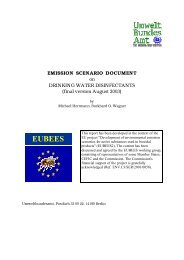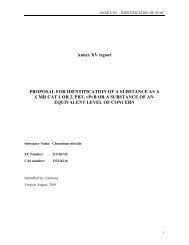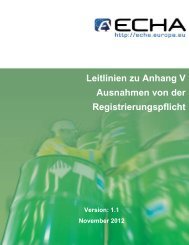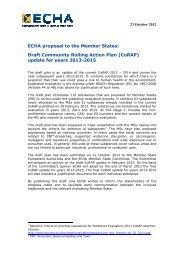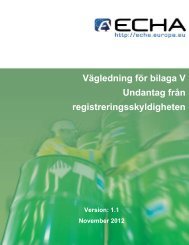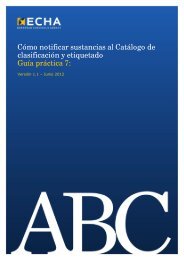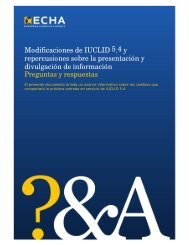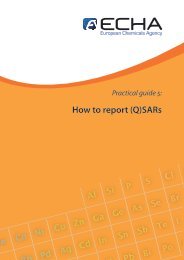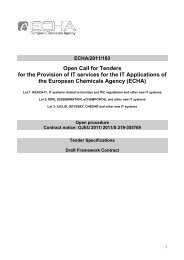Strategy For Limiting Risks Human Health Draft of ... - ECHA - Europa
Strategy For Limiting Risks Human Health Draft of ... - ECHA - Europa
Strategy For Limiting Risks Human Health Draft of ... - ECHA - Europa
You also want an ePaper? Increase the reach of your titles
YUMPU automatically turns print PDFs into web optimized ePapers that Google loves.
Repeated dose toxicity<br />
Local effects<br />
Inhalation exposure<br />
<strong>For</strong> prolonged inhalation exposure <strong>of</strong> workers to cryolite, data on possible health effects are<br />
available from different sources such as mining and processing <strong>of</strong> natural cryolite, production<br />
<strong>of</strong> syntethic cryolite and manufacturing <strong>of</strong> aluminium. There has been no indication for<br />
cryolite specific chronic respiratory effects in humans although specific examinations have<br />
been made (x-ray photography, pulmonary function tests, questionaires concerning incidences<br />
<strong>of</strong> acute pulmonary symptoms). Exposure in some cases has been rather high and longlasting,<br />
causing severe skeletal fluorosis.<br />
In a well-conducted 90-day inhalation study rats were exposed snout-only to particulate<br />
aerosols <strong>of</strong> cryolite in the concentration <strong>of</strong> 0, 0.21, 1.04, and 4.6 mg/m 3 . Alveolitis with<br />
interstitial thickening <strong>of</strong> alveolar duct walls and increased collagen in alveolar ducts occurred<br />
in the high dose group. At the intermediate dose <strong>of</strong> Cryolite, a proportion <strong>of</strong> rats had<br />
interstitial thickening <strong>of</strong> the alveolar duct walls. These effects might indicate <strong>of</strong> the start <strong>of</strong> a<br />
fibrotic process in the lung. At the low dose (0.21 mg/m 3 ) no effect was observed.<br />
<strong>For</strong> the risk assessment this NOAEC <strong>of</strong> 0.21 mg/m 3 is used as starting point concerning<br />
effects <strong>of</strong> cryolite after repeated inhalation.<br />
<strong>For</strong> the identification <strong>of</strong> the reference MOS the following aspects are taken into account: The<br />
human data give no indication for cryolite specific chronic respiratory effects. Therefore, the<br />
NOAEC gives a very precautious value for the evaluation <strong>of</strong> this endpoint. On that<br />
background it does not seem indicated to apply any additional assessment factors like inter- or<br />
intraspecies extrapolation or duration adjustment. On the other hand the NOAEC, based on a<br />
90-day study, might make a duration factor <strong>of</strong> about 2 necessary, because a progression <strong>of</strong><br />
effects in the lungs (thickening <strong>of</strong> alveolar ducts and increased collagen) cannot excluded. In<br />
summary for the reference MOS a value <strong>of</strong> about 2 is proposed; the critical exposure level<br />
calculates then to 0.1 mg/m 3 (0.2 mg/m 3 / 2).<br />
Table 2.2 shows, that all scenarios exceed the critical exposure level thus giving reason for<br />
concern.<br />
17<br />
Conclusion: iii






